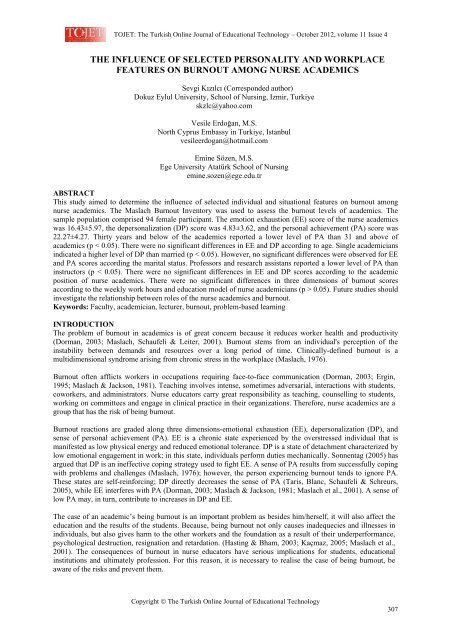october 2012 - TOJET the Turkish online journal of educational ...
october 2012 - TOJET the Turkish online journal of educational ...
october 2012 - TOJET the Turkish online journal of educational ...
You also want an ePaper? Increase the reach of your titles
YUMPU automatically turns print PDFs into web optimized ePapers that Google loves.
<strong>TOJET</strong>: The <strong>Turkish</strong> Online Journal <strong>of</strong> Educational Technology – October <strong>2012</strong>, volume 11 Issue 4<br />
THE INFLUENCE OF SELECTED PERSONALITY AND WORKPLACE<br />
FEATURES ON BURNOUT AMONG NURSE ACADEMICS<br />
Sevgi Kızılcı (Corresponded author)<br />
Dokuz Eylul University, School <strong>of</strong> Nursing, Izmir, Turkiye<br />
skzlc@yahoo.com<br />
Vesile Erdoğan, M.S.<br />
North Cyprus Embassy in Turkiye, Istanbul<br />
vesileerdogan@hotmail.com<br />
Emine Sözen, M.S.<br />
Ege University Atatürk School <strong>of</strong> Nursing<br />
emine.sozen@ege.edu.tr<br />
ABSTRACT<br />
This study aimed to determine <strong>the</strong> influence <strong>of</strong> selected individual and situational features on burnout among<br />
nurse academics. The Maslach Burnout Inventory was used to assess <strong>the</strong> burnout levels <strong>of</strong> academics. The<br />
sample population comprised 94 female participant. The emotion exhaustion (EE) score <strong>of</strong> <strong>the</strong> nurse academics<br />
was 16.43±5.97, <strong>the</strong> depersonalization (DP) score was 4.83±3.62, and <strong>the</strong> personal achievement (PA) score was<br />
22.27±4.27. Thirty years and below <strong>of</strong> <strong>the</strong> academics reported a lower level <strong>of</strong> PA than 31 and above <strong>of</strong><br />
academics (p < 0.05). There were no significant differences in EE and DP according to age. Single academicians<br />
indicated a higher level <strong>of</strong> DP than married (p < 0.05). However, no significant differences were observed for EE<br />
and PA scores according <strong>the</strong> marital status. Pr<strong>of</strong>essors and research assistans reported a lower level <strong>of</strong> PA than<br />
instructors (p < 0.05). There were no significant differences in EE and DP scores according to <strong>the</strong> academic<br />
position <strong>of</strong> nurse academics. There were no significant differences in three dimensions <strong>of</strong> burnout scores<br />
according to <strong>the</strong> weekly work hours and education model <strong>of</strong> nurse academicians (p > 0.05). Future studies should<br />
investigate <strong>the</strong> relationship between roles <strong>of</strong> <strong>the</strong> nurse academics and burnout.<br />
Keywords: Faculty, academician, lecturer, burnout, problem-based learning<br />
INTRODUCTION<br />
The problem <strong>of</strong> burnout in academics is <strong>of</strong> great concern because it reduces worker health and productivity<br />
(Dorman, 2003; Maslach, Schaufeli & Leiter, 2001). Burnout stems from an individual's perception <strong>of</strong> <strong>the</strong><br />
instability between demands and resources over a long period <strong>of</strong> time. Clinically-defined burnout is a<br />
multidimensional syndrome arising from chronic stress in <strong>the</strong> workplace (Maslach, 1976).<br />
Burnout <strong>of</strong>ten afflicts workers in occupations requiring face-to-face communication (Dorman, 2003; Ergin,<br />
1995; Maslach & Jackson, 1981). Teaching involves intense, sometimes adversarial, interactions with students,<br />
coworkers, and administrators. Nurse educators carry great responsibility as teaching, counselling to students,<br />
working on committees and engage in clinical practice in <strong>the</strong>ir organizations. Therefore, nurse academics are a<br />
group that has <strong>the</strong> risk <strong>of</strong> being burnout.<br />
Burnout reactions are graded along three dimensions-emotional exhaustion (EE), depersonalization (DP), and<br />
sense <strong>of</strong> personal achievement (PA). EE is a chronic state experienced by <strong>the</strong> overstressed individual that is<br />
manifested as low physical energy and reduced emotional tolerance. DP is a state <strong>of</strong> detachment characterized by<br />
low emotional engagement in work; in this state, individuals perform duties mechanically. Sonnentag (2005) has<br />
argued that DP is an ineffective coping strategy used to fight EE. A sense <strong>of</strong> PA results from successfully coping<br />
with problems and challenges (Maslach, 1976); however, <strong>the</strong> person experiencing burnout tends to ignore PA.<br />
These states are self-reinforcing; DP directly decreases <strong>the</strong> sense <strong>of</strong> PA (Taris, Blanc, Schaufeli & Schreurs,<br />
2005), while EE interferes with PA (Dorman, 2003; Maslach & Jackson, 1981; Maslach et al., 2001). A sense <strong>of</strong><br />
low PA may, in turn, contribute to increases in DP and EE.<br />
The case <strong>of</strong> an academic’s being burnout is an important problem as besides him/herself, it will also affect <strong>the</strong><br />
education and <strong>the</strong> results <strong>of</strong> <strong>the</strong> students. Because, being burnout not only causes inadequecies and illnesses in<br />
individuals, but also gives harm to <strong>the</strong> o<strong>the</strong>r workers and <strong>the</strong> foundation as a result <strong>of</strong> <strong>the</strong>ir underperformance,<br />
psychological destruction, resignation and retardation. (Hasting & Bham, 2003; Kaçmaz, 2005; Maslach et al.,<br />
2001). The consequences <strong>of</strong> burnout in nurse educators have serious implications for students, <strong>educational</strong><br />
institutions and ultimately pr<strong>of</strong>ession. For this reason, it is necessary to realise <strong>the</strong> case <strong>of</strong> being burnout, be<br />
aware <strong>of</strong> <strong>the</strong> risks and prevent <strong>the</strong>m.<br />
Copyright © The <strong>Turkish</strong> Online Journal <strong>of</strong> Educational Technology<br />
307
















